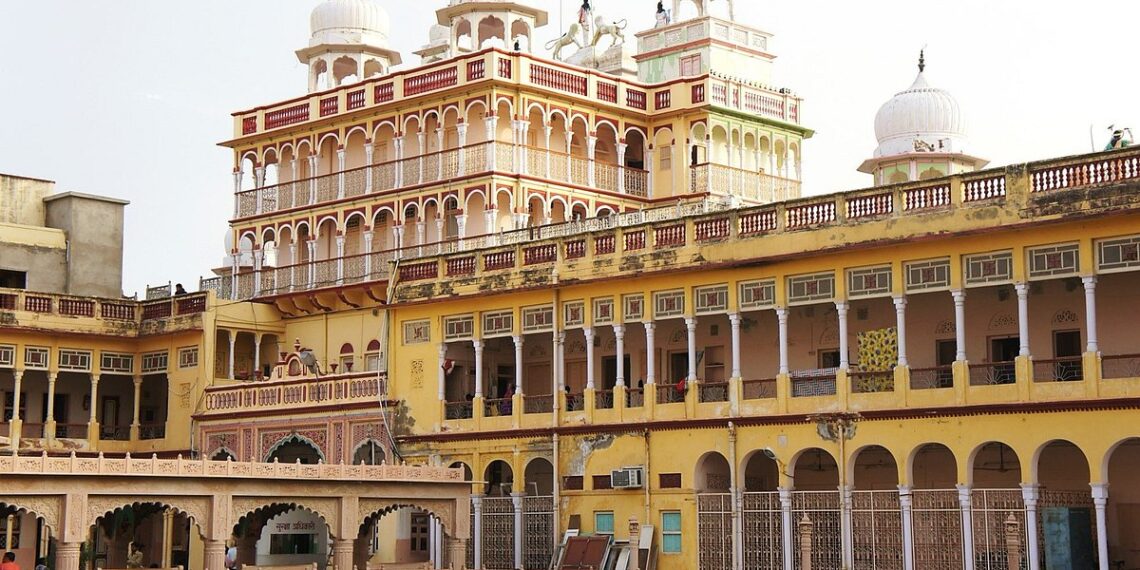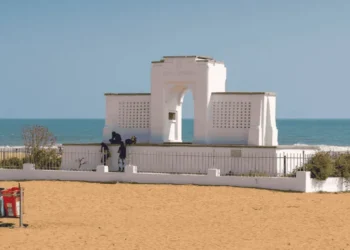Nestled in the busy streets of Jhunjhunu city in Rajasthan’s Shekhawati region, the Rani Sati Temple stands tall as a sacred site dedicated to Rani Sati, also known as Narayani Devi or Dadiji. Hailed as India’s grandest temple in her honor, it draws thousands of devotees who revere her as a symbol of bravery and devotion. With a history stretching back over four centuries, this marble shrine sparkles during the annual Bhado Amavasya fair.
History of Rani Sati Temple
The Rani Sati Temple in Jhunjhunu began as a small memorial mound in 1912, set up by the Jalan clan of the Agarwal community. By 1917, they started building the larger temple, finishing it in 1936. It honors Rani Sati, a woman from the 13th to 17th centuries who gave her life on her husband’s funeral pyre, a once-honored act of loyalty. Though sati is now illegal and the temple does not support it, the site remains a key pilgrimage spot. Managed by the Marwari Temple Board in Kolkata, it’s one of India’s richest temples, second only to Tirupati Balaji, earning about 20 lakh rupees yearly and holding assets worth 80 lakh rupees.
Stories Behind the Temple
The temple’s tales bring Rani Sati’s story to life. One legend ties her to the Mahabharata, where she was Uttara, wife of Abhimanyu. Heartbroken by his death, she wished to join him but was granted this in her next life as Narayani Devi. Born to Gursamal in Thukaye, Rajasthan, she married Tandhan, son of Jaliram from Hissar. Tandhan had a prized white mare that Hissar’s king’s son wanted. When Tandhan refused, a fight broke out. Tandhan killed the prince but was later slain by the king. Narayani fought back, killed the king, and then joined Tandhan on his pyre. She told Ranaji, the horse’s keeper, to build a shrine where her ashes fell, promising her name would live on as Rani Sati.
Another story says Narayani, a young Jalan bride, was traveling with her merchant husband when dacoits attacked, killing him. She fought bravely, died defending herself, and a temple was built where her horse stopped with their ashes. These tales, though different, paint Rani Sati as a fierce, devoted woman, seen as a form of Goddess Shakti.
Religious Significance of the Temple
The Rani Sati Temple is a spiritual haven, especially for the Marwari Agrawal community, who call her their family deity. Unlike most temples, it has no deity statue, focusing instead on a trishul (trident) and a portrait of Rani Sati in the Pardhan Mand, symbolizing Shakti’s power. People believe praying here brings safety, strength, and good fortune for families and businesses. The temple welcomes Hindus, Muslims, Sikhs, Christians, and Jains, showing India’s open spirit. On Bhado Amavasya, millions gather for the Pujanutsav, a big ritual to see the trishul. Daily aartis at 5:30 AM, 12:00 PM, and 7:00 PM, with chants and prasad, keep the temple’s holy flame burning.
Architecture of the Temple
The Rani Sati Temple is a gem of Rajasthani style, built in gleaming white marble, looking like a royal palace. It spans two courtyards with 300 rooms for pilgrims. The main hall shines with silver work and a ceiling of tiles and mirrors. A wall painting tells Rani Sati’s story—her life, her husband’s death, and the temple’s start. Instead of idols, the trishul and Rani Sati’s portrait take center stage. Smaller temples honor Lord Shiva, Ganesha, Hanuman, Sita-Ram, Lakshminarayan, and the Sodash Matrika (16 goddesses), with a big Shiva statue in a garden. Twelve smaller sati temples, built in 1762, honor other Jalan women, each with carved marble. Bright wall art and glass mosaics show the temple’s past, mixing Colonial and Rajput styles with arched paths and colorful railings featuring Krishna, Lakshmi, and Bhawani.
Interesting Facts About the Temple
The temple has special traits that make it stand out:
- It’s one of few Indian temples dedicated to a real person, not a god, honoring Rani Sati’s sacrifice.
- Worship centers on a trishul, not an idol, which is rare for Hindu temples.
- Run by the Kolkata-based Marwari Temple Board, it’s among India’s wealthiest temple trusts.
- The Bhado Amavasya fair pulls in millions, uniting different faiths in prayer.
- The 12 smaller sati temples, with their marble carvings, add a rich layer of history.
Visiting Information for Rani Sati Temple
How to Get There
The temple sits in Jhunjhunu’s Chobari Mandi Colony, easy to reach by different ways.
By Air: Jaipur International Airport, 185 kilometers away, is closest. Taxis or buses to Jhunjhunu take 3–4 hours.
By Train: Jhunjhunu Railway Station, 3 kilometers away, links to Jaipur, Delhi, and Sikar. Autos or taxis to the temple take 10–15 minutes.
By Road: Jhunjhunu connects via RJ-SH 8 to Jaipur (180 km), Sikar (70 km), and Delhi (230 km). Local taxis, buses, or autos from the city center get you there fast.
Temple Hours
Open daily from 5:00 AM to 1:00 PM and 3:00 PM to 10:00 PM. Aartis are at 5:30 AM, 12:00 PM, and 7:00 PM, with prasad after. During Bhado Amavasya or Mangsir Badi Navmi, hours may stretch—ask temple staff.
Best Time to Go
November to March has cool weather (10–25°C), perfect for visiting. The Bhado Amavasya fair in August–September is full of life but packed. Summers (April–June) hit 40°C, so go early. Monsoons (July–September) can make roads slick, so plan ahead.
Rules for Visitors
- Wear proper clothes: men need shirts, trousers, or dhotis with a cloth over the shoulder; women need sarees or churidar with a dupatta. No jeans or shorts.
- Take off shoes before entering; there’s a spot to keep them.
- No smoking, alcohol, or loud talk allowed.
- Ask temple staff before taking pictures in the main hall.
- Entry is free, but puja or prasad donations help the temple.
- Bring water; don’t bring food, as animals might grab it.
- Dharamshala rooms (Rs. 100–700) and a canteen offer cheap meals and snacks.
Nearby Attractions
Khetri Mahal: 7 km away, an old palace with fine design.
Modi and Tibrewala Havelis: 5–10 km away, with Shekhawati’s famous wall paintings.
Mandawa Fort: 30 km away, a heritage spot with grand havelis.
Bihari Ji Temple: 5 km away, a calm place for prayer.











